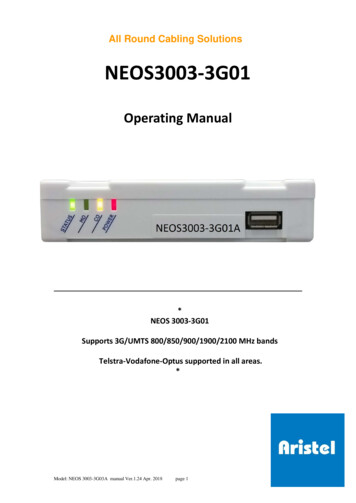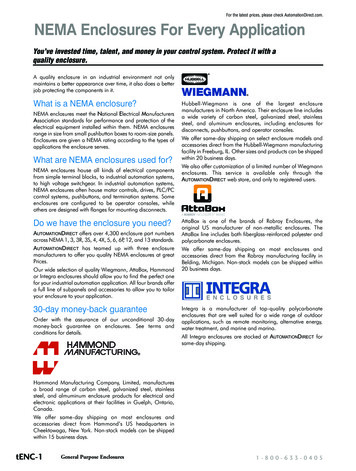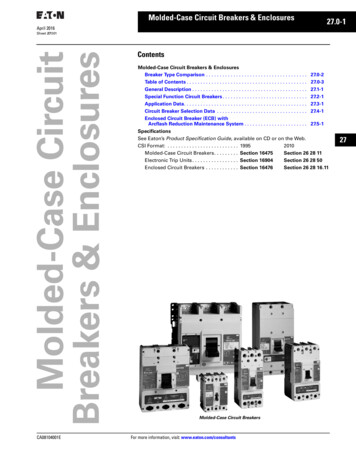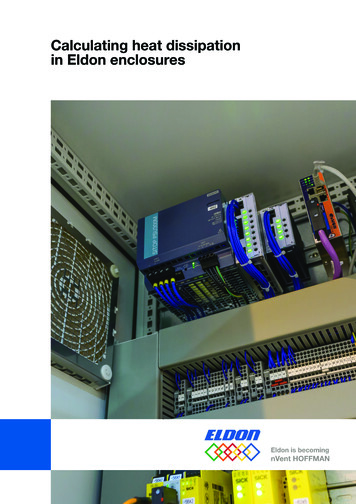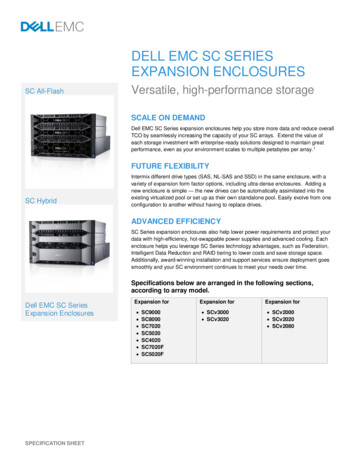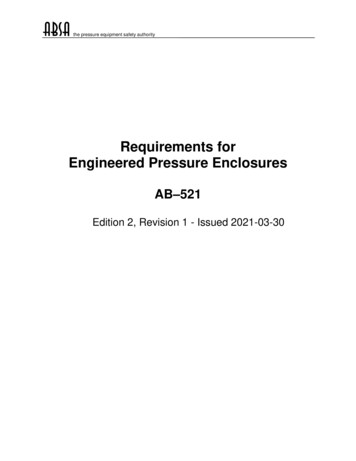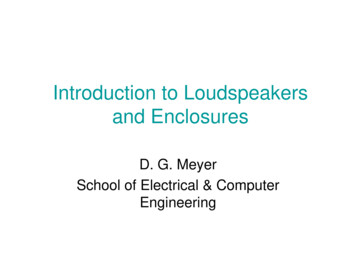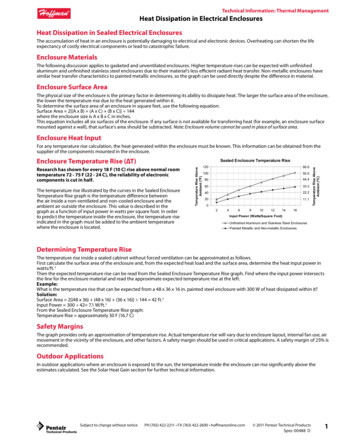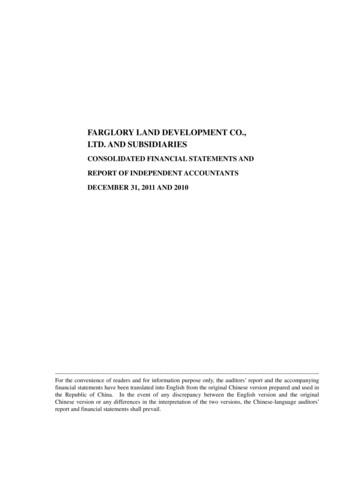Transcription
B&R Enclosures Pty LtdAnti-Condensation in Electrical EnclosuresTechnical Paper
INTRODUCTIONWhen conditions are humid or thetemperature in an environmentsuddenly drops, the water heldin the air around us, cannot staysuspended as a gas anymoreand must condense back intowater. It does this on any coldsurfaces it can find includingcar windows, grass, mirrors etc.The temperature at which thishappens is called the DEW POINTand the water that condensesis known as condensation (ordew). This same effect cancause problems with electricalequipment as condensation canoccur inside enclosures and onsensitive equipment if they arenot suitably protected.DEW POINT DEFINITIONThe dew point is the temperature at which air is saturatedwith moisture and cannot hold any more. The dew point is thetemperature at which full saturation of air with water occurs, iewhen the relative humidity is 100%. If air comes into contact witha surface cooler than the dew point, then dew or condensationis formed on the surface. This is why dew often forms at night orearly morning: As the temperature of the air falls, the amount ofwater vapour the air can hold also decreases. Excess water vapourthen condenses into very small droplets on whatever it touches.HOW CONDENSATION HAPPENSWe should assume that air pressure is always the same, andthat all these changes happen in open air at constant conditions.Air can only absorb a certain amount of moisture in the formof water vapour. When the air cools the amount of water the aircan absorb is reduced (see graph 1). The excess water vapourcondenses onto any cool (below the dew point) surface it canfind as dew.For example:If the air temperature is 20ºC, then based on graph 1 thesaturation of water vapour in the air is 1.8%. If the air were tocool, then the saturation point decreases, thus forcing the excesswater vapour to condense. This is what happens when you takea bottle out of the fridge. Initially it has no condensation or dewon it and the bottle is dry, but within a short time the air aroundthe bottle cools below the dew point and the water in the air thenforms condensation on the bottle. In high humidity conditions(where there is a lot of water in the air) this happens very easily,as a slight cooling of the air, while in very dry low humidityconditions this effect may not even be noticed.The same happens inside an enclosure. In the morning the airtemperature is low and with equipment switched off, there isno heat being generated inside the enclosure, giving an idealsurface for dew to form on the inside of the enclosure. Once thewater vapour has formed into water droplets, it then takes sometime for the water to re-evaporate as the day gets warmer.B&R Enclosures Pty Ltd brenclosures.com.auGraph 1: Saturation Fraction of Water In Air at Sea Level
HOW TO STOP CONDENSATIONSIZING ANTICONDENSATION HEATERSTo stop condensation or dew from forming inside an enclosure, thefollowing steps may be useful:For extreme conditions and typical enclosure dimensions, thefollowing table gives the recommended anticondensation sizesfor a given enclosure’s air volume. For extreme conditions orenclosures with unusual aspect ratios, consult B&R for advice.1.Increase the temperature to above the dew point.The most effective method is to install an anticondensation heatercontrolled by a humidistat. As the ambient air temperature coolsdown, so does the air inside the enclosure and it becomes moresaturated with water. If the temperature goes below the dewpoint then the water vapour starts to condense on the inside ofthe enclosure. The humidistat detects the increase in humidityand switches on an anticondensation heater to stop the enclosuretemperature going below the dew point. The major advantage ofa humidistat over a thermostat is that if the humidity is low andcold then it will not switch the heater on, which over time willsave a considerable amount of energy. B&R offers fan forcedanticondensation heaters and humidistats that are DIN railmountable. Ideally these anti-condensation heaters need to befitted as close to the top of the enclosure as possible.2.Enclosure volume[m3]Heater Wattage[Watts] 1m350WTX-WID05ZXOP 1m3 but 2m3100WTX-WID10BLOC 2m3 but 3m3150WTX-WID15BLOC 3m3 but 4m3200WTX-WID20BLOC300WTX-WID30BLOC 4m3 but 5m3HumidistatHeaterCatalogue NumberTX-AAWHS10Decreasing humidityAnother method used is decreasing humidity. This can be donewith de-humidifiers.a.The first type is a mechanical/refrigerative dehumidifier. Thisis the most common type and usually works by drawingmoist air over a refrigerated coil with a small fan. Sincethis increases the saturation of water vapour, it allows itto condense on to the coils, where it drips into a collectingbucket or via a pipe out of the enclosure. This methodhowever is somewhat more difficult to implement.b.A second type is an electronic dehumidifier which uses aPeltier heat pump to generate a cool surface for condensingthe water vapour from the air. This type of dehumidifier hasthe benefit of being very quiet when in use as there is nomechanical compressor. This design is mainly used for verysmall dehumidifiers, with its simple design and low cost parts.It can also be useful on electrical enclosures.Note: implementation is still significantly more difficult than aanti-condensation heater as a collecting bucket or outlet pipewould need to be installed.c.A third dehumidifier is a dry chemical dehumidifier. Thedisadvantage of these dehumidifiers is that they need tobe replaced regularly and therefore require both ongoingmaintenance and waste disposal.Fan Forced HeatersHumidistatsPelter cells shown withoutcontrol equipmentDry chemical dehumidifier
FURTHER EXPLANATIONSCALCULATIONSAir pressure also has an effect on the dew point. The higher theair pressure the easier it is for the water vapour to condense.For a given temperature and humidity, if the pressure isincreased then water vapour can condense into dew.Outside air pressure changes quickly, the seals in an IP66enclosure can make the enclosures reaction to those changesslower, leading to a slight pressure differential between theenclosure and outside environment. This can have the effectof causing water vapour to condense on the inside of theenclosure. A solution to this problem would be to vent theenclosure to ensure equal pressure. Venting can sometimes bea problem as it may compromise the IP rating of the enclosurebut this can be solved with “Goretex” vents which allow airto pass through but not liquids. Some sites even have a policyto open enclosure doors to ventilate them during very lowhumidity days so as to trap as little moisture in the enclosureas possible. This may not eliminate condensation but it doeseffectively reduce the mass of water inside the enclosure, inturn limiting the possibility for condensation to form.Calculating the dew point.Dew point can be read from the graph opposite or a simpleapproximation calculation formula shown below.An approximation formula for calculating Dew point is:Td T -100 - RH5Where Td is the dew point, T is the air temperature (C) and RHis the relative humidity (%).For example:if the current humidity is 50% and the ambient airtemperature is 20 C then the Dew point is:10 C {20-(100-50)/5) 10}.Relative humidity and temperature values for an area canusually be obtained from the Bureau of Meteorology oron-site measurement.DisclaimerThis technical paper has been prepared specifically for customers of the publisher and as a general reference only. B&R Enclosures Pty Ltd engages in a policy of continuousdevelopment and improvement of its products and reserves the right to alter, add and/or delete specifications of any products or equipment without notice and withoutincurring liability. The publisher and any party associated with the production of this technical paper do not accept any responsibility or liability whatsoever (to the extentpermitted by law) for any inaccuracy, error, misinformation or misleading statements, whether negligently caused or otherwise, contained in this publication. This publicationis protected by copyright and may not be reproduced or copied (using any method of reproduction or copying), sold, transmitted, circulated or otherwise forwarded to thirdparties, in whole or part, without prior written consent of the author. All registered trademarks and product names appearing herein are the property of the respective owners.B&R Enclosures Pty Ltd brenclosures.com.au
Head OfficeVIC & TAS Office – Sales & Warehouse51 Stradbroke Street Heathwood QLD 4110 AustraliaPO Box 1151 Browns Plains BC QLD 4118 AustraliaT: 61 7 3714 1000 F: 61 7 3714 108150-52 Sunmore Close Heatherton VIC 3202 AustraliaT: 61 3 9552 0552 F: 61 3 9551 8636QLD Office – Sales & Warehouse51 Stradbroke Street Heathwood QLD 4110 AustraliaPO Box 1151 Browns Plains BC QLD 4118 AustraliaT: 61 7 3714 1111 F: 61 7 3714 1091North QLD Office – Sales & Warehouse25 Dalrymple Road Garbutt QLD 4814 AustraliaPO Box 7615 Garbutt QLD 4815 AustraliaT: 61 7 4727 1900 F: 61 7 4755 0675NSW & ACT Office – Sales & WarehouseUnit 12/100 Belmore Road North Riverwood NSW 2210 AustraliaPO Box 90 Riverwood NSW 2210 AustraliaT: 61 2 9915 9555 F: 61 2 9584 0055Newcastle – DistributionRoss Joice Agencies Pty Ltd109-111 Broadmeadow Road Broadmeadow NSW 2292 AustraliaT: 61 2 4961 4433 F: 61 2 4961 2498SA & NT Office – Sales & Warehouse505 Grand Junction Way Wingfield SA 5013 AustraliaT: 61 8 8417 6222 F: 61 8 8268 3675Northern Territory – DistributionJewell Distributors Pty LtdCnr Hidden Valley & Beaton Roads Berrimah NT 0828 AustraliaT: 61 8 8947 0870 F: 61 8 8947 0764WA Office – Sales & Warehouse6 Montgomery Way Malaga WA 6090 AustraliaT: 61 8 6310 4777 F: 61 8 9249 6776National SalesT: 1300 Enclosures (1300 362 567)F: 1300 796 599E: sales@brenclosures.com.aubrenclosures.com.au
as a slight cooling of the air, while in very dry low humidity conditions this effect may not even be noticed. The same happens inside an enclosure. In the morning the air temperature is low and with equipment switched off, there is no heat being generated inside the enclosure, giving an ideal surface for dew to form on the inside of the enclosure. Once the water vapour has formed into water .
